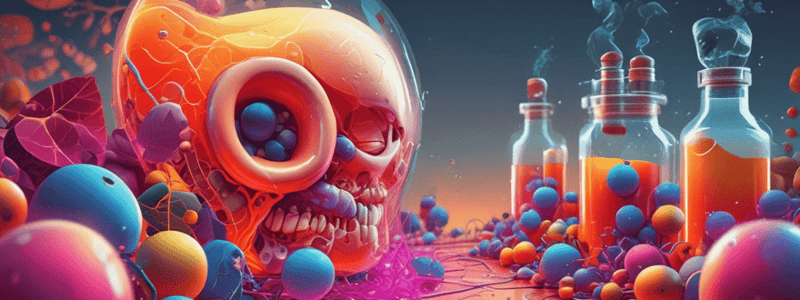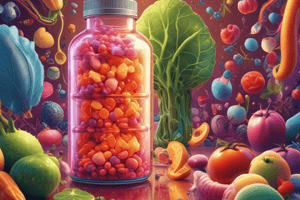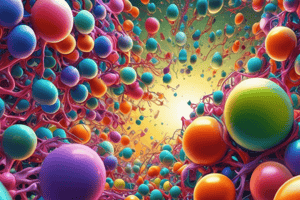Podcast
Questions and Answers
What is the primary function of catabolism?
What is the primary function of catabolism?
- To store excess energy in the form of glycogen or fat
- To facilitate protein synthesis in cells
- To break down large molecules into smaller ones (correct)
- To synthesize new cells and tissues
Which of the following hormones is NOT a catabolic hormone?
Which of the following hormones is NOT a catabolic hormone?
- Epinephrine
- Glucagon
- Insulin (correct)
- Cortisol
What is the primary function of ATP in cellular metabolism?
What is the primary function of ATP in cellular metabolism?
- To provide energy for anabolic reactions (correct)
- To store excess energy in the form of glycogen
- To release heat as a byproduct of catabolism
- To facilitate the breakdown of proteins into amino acids
Which of the following molecules is NOT a product of fat (lipid) catabolism?
Which of the following molecules is NOT a product of fat (lipid) catabolism?
What is the primary function of nucleic acid metabolism in cells?
What is the primary function of nucleic acid metabolism in cells?
What is the approximate percentage of energy released from catabolism that is transferred to ATP?
What is the approximate percentage of energy released from catabolism that is transferred to ATP?
What is the primary function of anabolic hormones?
What is the primary function of anabolic hormones?
Which process involves the conversion of pyruvate to lactic acid?
Which process involves the conversion of pyruvate to lactic acid?
What is the fate of pyruvate in the absence of oxygen in humans?
What is the fate of pyruvate in the absence of oxygen in humans?
Which molecule acts as the final electron receptor in aerobic respiration?
Which molecule acts as the final electron receptor in aerobic respiration?
What is the primary role of the Electron Transport Chain (ETC) in cellular respiration?
What is the primary role of the Electron Transport Chain (ETC) in cellular respiration?
During lipolysis, what happens to fatty acids for energy production?
During lipolysis, what happens to fatty acids for energy production?
What triggers the release of pancreatic lipase and bile salts for lipid digestion?
What triggers the release of pancreatic lipase and bile salts for lipid digestion?
What is the primary function of triglycerides?
What is the primary function of triglycerides?
What occurs during gluconeogenesis?
What occurs during gluconeogenesis?
What happens when ketogenesis occurs?
What happens when ketogenesis occurs?
What happens to excess protein in the body?
What happens to excess protein in the body?
During the Absorptive state, what is the primary role of insulin?
During the Absorptive state, what is the primary role of insulin?
In the Postabsorptive state, what hormone is released due to low insulin levels?
In the Postabsorptive state, what hormone is released due to low insulin levels?
Which metabolic state prioritizes conserving amino acids for protein synthesis?
Which metabolic state prioritizes conserving amino acids for protein synthesis?
What is the main purpose of the urea cycle?
What is the main purpose of the urea cycle?
Which organ primarily controls sweating to cool the body?
Which organ primarily controls sweating to cool the body?
Which form of heat transfer is responsible for about 60% of heat loss?
Which form of heat transfer is responsible for about 60% of heat loss?
What is the main energy expenditure during Basal Metabolic Rate (BMR)?
What is the main energy expenditure during Basal Metabolic Rate (BMR)?
How does obesity develop according to the text?
How does obesity develop according to the text?
What does Basal Metabolic Rate (BMR) measure?
What does Basal Metabolic Rate (BMR) measure?
Study Notes
Metabolism
- Metabolism is the sum of all chemical reactions involved in catabolism and anabolism.
- Catabolism is the breakdown of large molecules (food) into smaller molecules, releasing energy.
- Anabolism is the use of energy from catabolic reactions to build small molecules into large molecules.
Energy and ATP
- About 40% of energy released from catabolism is transferred to ATP, while 60% is given off as heat.
- ATP is composed of adenine, ribose, and 3 phosphate groups.
- ATP breaks down into ADP and an inorganic phosphate group.
Catabolism of Macromolecules
- Carbohydrates break down into glucose, primarily used for energy.
- Fats break down into glycerol and fatty acids, stored in adipocytes unless needed for energy.
- Proteins break down into amino acids, facilitating protein synthesis in cells.
- Nucleic acids are used for nucleic acid metabolism in each cell.
Hormones
- Catabolic hormones: cortisol, glucagon, epinephrine, and cytokines.
- Anabolic hormones: growth hormone, insulin-like growth factor, insulin, testosterone, and estrogen.
Redox Reactions
- Oxidation is the loss of an electron, with energy transferred to the next molecule.
- Reduction is the gain of an electron.
- Redox reactions are catalyzed by enzymes, involving the removal of hydrogen atoms and electron transfer.
Carbohydrate Metabolism
- Carbohydrates are organic molecules made of carbon, hydrogen, and oxygen.
- Glycolysis is the breakdown of glucose to create ATP, NADH, and pyruvate.
- Anaerobic respiration occurs without oxygen, converting pyruvate to lactic acid.
- Aerobic respiration occurs with oxygen, converting pyruvate to ATP through the Krebs cycle.
Krebs Cycle and Electron Transport Chain
- The Krebs cycle (Citric Acid Cycle) converts pyruvate into acetyl CoA, producing ATP, NADH, and FADH2.
- The Electron Transport Chain (ETC) generates ATP using NADH and FADH2, transferring electrons to oxygen.
Lipid Metabolism
- Lipid metabolism is the oxidation of fatty acids to generate energy or synthesize new lipids.
- Triglycerides are broken down by pancreatic lipase and emulsified by bile salts.
- Lipolysis is the breakdown of fat stores for energy.
- Ketogenesis occurs during low carbohydrate intake, fasting, or starvation, producing ketone bodies.
Protein Metabolism
- Protein is used for growth and repair, and can also be used as fuel.
- Excess protein is converted to glucose or triglycerides and stored in energy reserves.
- The urea cycle produces urea from ammonium ions, removing nitrogenous waste.
Metabolic States
- The Absorptive state is the digestive and absorptive phase, lasting up to 4 hours.
- The Postabsorptive state is a fasting state, relying on stored glycogen and promoting gluconeogenesis.
- The Starvation state is a survival mode, prioritizing glucose to the brain, conserving amino acids, and eventually using ketones for fuel.
Thermoregulation
- Thermoregulation maintains body temperature near 98.6°F in times of heat and cold.
- About 60% of energy production is in the form of heat, maintaining body temperature.
- The hypothalamus controls sweating and shivering to regulate body temperature.
Metabolic Rate and Energy
- The Metabolic Rate is the energy consumed minus energy expended.
- Basal Metabolic Rate (BMR) is the energy expended at rest, in a neutral environment, and in a postabsorptive state.
- A calorie is the amount of heat required to raise 1 g of water by 1°C.
- Overweight and obesity occur when consuming more calories than expended.
Vitamins
- Vitamins are organic compounds essential for biochemical reactions in the body.
- Vitamin B plays a significant role in metabolism.
Studying That Suits You
Use AI to generate personalized quizzes and flashcards to suit your learning preferences.
Description
Test your knowledge on metabolism and catabolism, the processes of breaking down large molecules for energy and storing excess energy in the body. Learn about catabolic hormones that influence body function and how the body utilizes stored energy for anabolism.




